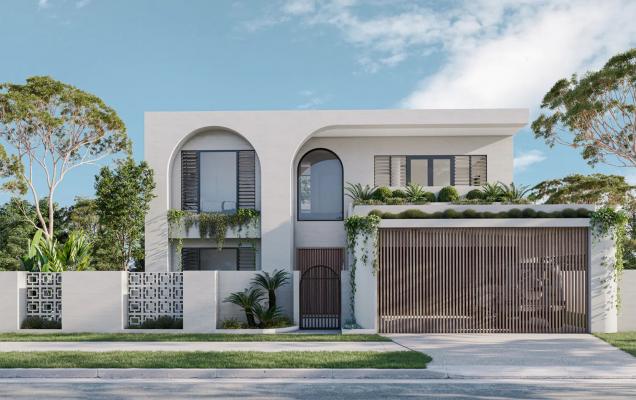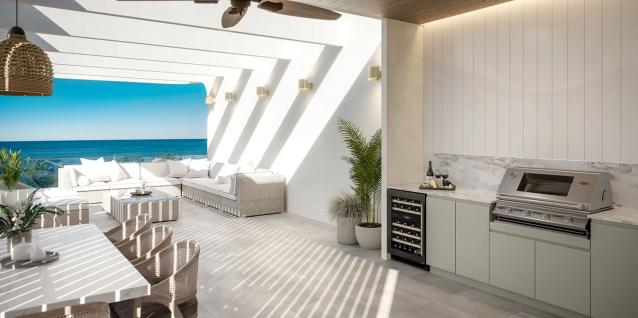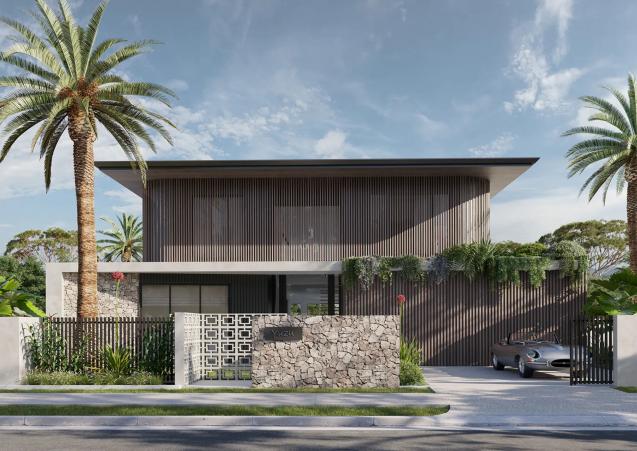
How Can Clever Design Be Used to Make a Small House Feel Big?
By Unique Built|February 22, 2024
In the world of home design, size isn't always the defining factor of space – it's how you use it. Not everyone has the luxury of a three storey house design. You’ve likely heard tales of small house plans miraculously transformed into seemingly expansive abodes, haven't you?
Well, this is not about pulling rabbits out of hats, but about smart design choices that make every square inch count. For you, the aspiring homeowner dreaming of a cosy yet spacious sanctuary, or the engineer seeking to master the art of efficient space design, this revelation is for you.
Forget the claustrophobic corridors and cramped kitchens of the past. The future of small house plans lies in innovative design elements that cleverly deceive the eye, expand usable space, and enhance overall functionality. These aren't just tricks of the trade; they're about making intelligent, calculated decisions that transform the ordinary into the extraordinary.
The Magic of Multi-Functionality
Imagine a wall bed, often known as a Murphy bed – though, let's be honest, it's far more sophisticated than the old slapstick comedy sketches might suggest. By day, it's an innocuous wall panel or shelf; by night, it transforms into a comfortable bed. This isn't just a space-saving trick; it's a testament to engineering innovation. The mechanics behind a wall bed involve a blend of counterbalanced hinges and supports, allowing it to seamlessly transition between its dual purposes without turning your nightly routine into a workout session.
Now, let's talk about the convertible desk. By day, it's your powerhouse workstation; by night, it could be a dining table or vanish entirely into sleek wall storage. The ingenuity here lies in the design's adaptability – using durable hinges and sliders that can withstand daily metamorphosis, all while maintaining a stylish appearance. This isn’t just furniture; it's a transformer in your living space (sans the robots-in-disguise part).
So, here's a moment for some reflection. Look around your own living space. Could a wall bed free up your floor space for daytime activities? Might a convertible desk mean no more dining table doubling as a cluttered, makeshift office? Multi-functionality in furniture isn't just about saving space; it's about creating a dynamic home environment that adapts to your life, not the other way around.
Lighting and Colour Tricks
Lighting and colour are the unsung heroes in the battle against cramped spaces. You might not realise it, but these two elements are like the dynamic duo of interior design, working behind the scenes to transform your perception of space. It's not about fancy gadgets or expensive renovations; it's about understanding how light and colour interact with your environment.
Lighting
When it comes to lighting, think of it as the mood setter of your home. The right lighting can turn what might otherwise feel like a gloomy dungeon into a bright, welcoming space. And no, we're not suggesting you install a chandelier in every room (though that would certainly make a statement!). It's about choosing the right type of lighting for each area.
For instance, layer your lighting with a mix of ambient, task, and accent lights. Ambient lighting provides overall illumination, think ceiling fixtures or wall-mounted lights. Task lighting is more focused, ideal for reading or cooking – a stylish desk lamp or under-cabinet lighting can do wonders here. Accent lighting? That's your secret weapon for highlighting architectural features or artwork, adding depth and dimension to a room.
The Colour Palette
The shades you choose for your walls, flooring, and furnishings can dramatically alter how big or small a space feels. Lighter colours are your allies in making a room feel airier and more open. Whites, light blues, and soft greys are great choices. But don't shy away from bold colours; used strategically, they can create focal points and add character without overwhelming the space.
An interior designer we chatted with put it perfectly: "Think of your walls as the canvas and your furnishings as the brushstrokes. You want to create a masterpiece, not a mishmash." This means balancing your colour scheme so that it flows seamlessly, without any jarring transitions.
The Open Floor Plan Revolution
Have you ever stepped into a home and felt an immediate sense of freedom and space, despite its actual size? That's the magic of open floor plans – a design revolution that's changing the way we think about small home spaces.
How does this concept create an airy feel? And what are the little challenges that come with it?
Embracing Spaciousness through Design
Open floor plans break down walls, literally, to create a single, large living space typically combining the kitchen, dining, and living areas. It’s like removing the boundaries that make a space feel boxed in. For you, this means more room to move, breathe, and live without the constraints of traditional room divisions. It's about transforming a collection of small rooms into one expansive living area.
The Airy Feel and Its Acoustic Counterpart
While an open plan lends an undeniable airy feel to a home, it's not without its quirks. Sound travels freely in open spaces – great for when you want the music to fill your home, not so great when you're trying to mask the sound of chopping onions while someone's binging the latest TV show. Engineers and architects often tackle this with clever design elements like acoustic panels or strategically placed furniture. But let's be honest, sometimes, overhearing every kitchen clatter or whispered secret just adds to a home's charm!
Structuring Open Floor Plans
From an architect's perspective, structuring an open floor plan is a delicate balance of aesthetics and functionality. It's not just about taking a sledgehammer to walls. Structural integrity is key, so load-bearing walls and support elements must be considered. This is where the expertise of an engineer often becomes invaluable. They ensure that while you're enjoying your wide-open space, your house remains, well, standing.
Moreover, an architect will tell you that it's not just about open space, but how you define it. Strategic placement of furniture, varied floor materials, and changes in ceiling height can create 'zones' within an open plan, subtly separating areas without the need for walls. This approach maintains the openness while giving a sense of order and distinction between functional areas of your home.
Big Windows, Big Dreams
Let's face it, you might not be living in a grandiose mansion, but who says you can't enjoy the same sense of openness and freedom?
Big windows are the game-changer in small house designs. These aren't just openings in a wall; they are like portals to a more spacious world. When you let in the light, you let in life, and suddenly, your modest abode feels less like a shoebox and more like a palace.
The Magic of Natural Light
The power of natural light through large windows is not just about brightening a room. It's a subtle, yet profound way to visually expand your living space. Think about it – a well-lit room feels airier, more inviting. It's not rocket science, it's just smart design. And hey, there's a bonus: you get a front-row seat to the ever-changing art show we call the sky.
Engineering the Dream
Integrating large windows isn't just about cutting a bigger hole in the wall. It involves considerations like load-bearing structures. You can't compromise the integrity of your home for the sake of a view, right? The key is finding that sweet spot where architectural safety meets aesthetic nirvana. It's a bit like being a tightrope walker, only less scary and with more predictable physics.
And here's a fascinating nugget: natural light doesn't just make your room look bigger; it actually makes you feel better. It's true!
Studies have shown that natural light can boost your mood and even increase productivity. So, those big windows are not just pleasing to the eye; they're like a daily dose of vitamin D for your soul.
The Vertical Space Frontier
You see, when it comes to small house plans, the sky (or rather, the ceiling) is the limit. Utilizing vertical space is like finding hidden real estate within your home that you never knew existed.
Embracing the Heights with Shelving
We're not talking about your grandma's dusty bookshelves. Modern shelving solutions are innovative and sleek, seamlessly integrating into your living space without screaming for attention. For you, the engineer, consider the balance between strength and aesthetics – a shelf isn't just a holding space; it's a feature of structural integrity. And for the homeowners among us, think of shelves as the perfect stage to display your personality, from beloved book collections to quirky knick-knacks. The best part is that most of these shelves are within easy reach, so let's leave the climbing expeditions to the mountaineers, shall we?
Hanging Gardens
Hanging plants aren’t just a nod to the Hanging Gardens of Babylon; they're a stylish way to bring life into a small space. This isn't about turning your living room into a jungle (unless that's your thing – no judgment here). It's about strategically placing plants to create a sense of freshness and openness. And for those with a technical mind, it’s a lesson in balance and weight distribution – important factors when you're suspending anything, plant or otherwise.
Lofted Areas
Now, before you think it’s all about beds hovering in mid-air, let's broaden that horizon. Lofts can be ingenious spaces for reading nooks, mini-offices, or even a cosy spot for some me-time. It's about maximising the cubic footage of your home. For the engineers tuning in, it’s a fascinating exercise in maximising space without compromising on structural integrity.
Clever design and careful can help make a smaller sized home feel larger than it really is. Speak to an award-winning Brisbane custom homes builder today.
Well, this is not about pulling rabbits out of hats, but about smart design choices that make every square inch count. For you, the aspiring homeowner dreaming of a cosy yet spacious sanctuary, or the engineer seeking to master the art of efficient space design, this revelation is for you.
Forget the claustrophobic corridors and cramped kitchens of the past. The future of small house plans lies in innovative design elements that cleverly deceive the eye, expand usable space, and enhance overall functionality. These aren't just tricks of the trade; they're about making intelligent, calculated decisions that transform the ordinary into the extraordinary.
The Magic of Multi-Functionality
Imagine a wall bed, often known as a Murphy bed – though, let's be honest, it's far more sophisticated than the old slapstick comedy sketches might suggest. By day, it's an innocuous wall panel or shelf; by night, it transforms into a comfortable bed. This isn't just a space-saving trick; it's a testament to engineering innovation. The mechanics behind a wall bed involve a blend of counterbalanced hinges and supports, allowing it to seamlessly transition between its dual purposes without turning your nightly routine into a workout session.
Now, let's talk about the convertible desk. By day, it's your powerhouse workstation; by night, it could be a dining table or vanish entirely into sleek wall storage. The ingenuity here lies in the design's adaptability – using durable hinges and sliders that can withstand daily metamorphosis, all while maintaining a stylish appearance. This isn’t just furniture; it's a transformer in your living space (sans the robots-in-disguise part).
So, here's a moment for some reflection. Look around your own living space. Could a wall bed free up your floor space for daytime activities? Might a convertible desk mean no more dining table doubling as a cluttered, makeshift office? Multi-functionality in furniture isn't just about saving space; it's about creating a dynamic home environment that adapts to your life, not the other way around.
Lighting and Colour Tricks
Lighting and colour are the unsung heroes in the battle against cramped spaces. You might not realise it, but these two elements are like the dynamic duo of interior design, working behind the scenes to transform your perception of space. It's not about fancy gadgets or expensive renovations; it's about understanding how light and colour interact with your environment.
Lighting
When it comes to lighting, think of it as the mood setter of your home. The right lighting can turn what might otherwise feel like a gloomy dungeon into a bright, welcoming space. And no, we're not suggesting you install a chandelier in every room (though that would certainly make a statement!). It's about choosing the right type of lighting for each area.
For instance, layer your lighting with a mix of ambient, task, and accent lights. Ambient lighting provides overall illumination, think ceiling fixtures or wall-mounted lights. Task lighting is more focused, ideal for reading or cooking – a stylish desk lamp or under-cabinet lighting can do wonders here. Accent lighting? That's your secret weapon for highlighting architectural features or artwork, adding depth and dimension to a room.
The Colour Palette
The shades you choose for your walls, flooring, and furnishings can dramatically alter how big or small a space feels. Lighter colours are your allies in making a room feel airier and more open. Whites, light blues, and soft greys are great choices. But don't shy away from bold colours; used strategically, they can create focal points and add character without overwhelming the space.
An interior designer we chatted with put it perfectly: "Think of your walls as the canvas and your furnishings as the brushstrokes. You want to create a masterpiece, not a mishmash." This means balancing your colour scheme so that it flows seamlessly, without any jarring transitions.
The Open Floor Plan Revolution
Have you ever stepped into a home and felt an immediate sense of freedom and space, despite its actual size? That's the magic of open floor plans – a design revolution that's changing the way we think about small home spaces.
How does this concept create an airy feel? And what are the little challenges that come with it?
Embracing Spaciousness through Design
Open floor plans break down walls, literally, to create a single, large living space typically combining the kitchen, dining, and living areas. It’s like removing the boundaries that make a space feel boxed in. For you, this means more room to move, breathe, and live without the constraints of traditional room divisions. It's about transforming a collection of small rooms into one expansive living area.
The Airy Feel and Its Acoustic Counterpart
While an open plan lends an undeniable airy feel to a home, it's not without its quirks. Sound travels freely in open spaces – great for when you want the music to fill your home, not so great when you're trying to mask the sound of chopping onions while someone's binging the latest TV show. Engineers and architects often tackle this with clever design elements like acoustic panels or strategically placed furniture. But let's be honest, sometimes, overhearing every kitchen clatter or whispered secret just adds to a home's charm!
Structuring Open Floor Plans
From an architect's perspective, structuring an open floor plan is a delicate balance of aesthetics and functionality. It's not just about taking a sledgehammer to walls. Structural integrity is key, so load-bearing walls and support elements must be considered. This is where the expertise of an engineer often becomes invaluable. They ensure that while you're enjoying your wide-open space, your house remains, well, standing.
Moreover, an architect will tell you that it's not just about open space, but how you define it. Strategic placement of furniture, varied floor materials, and changes in ceiling height can create 'zones' within an open plan, subtly separating areas without the need for walls. This approach maintains the openness while giving a sense of order and distinction between functional areas of your home.
Big Windows, Big Dreams
Let's face it, you might not be living in a grandiose mansion, but who says you can't enjoy the same sense of openness and freedom?
Big windows are the game-changer in small house designs. These aren't just openings in a wall; they are like portals to a more spacious world. When you let in the light, you let in life, and suddenly, your modest abode feels less like a shoebox and more like a palace.
The Magic of Natural Light
The power of natural light through large windows is not just about brightening a room. It's a subtle, yet profound way to visually expand your living space. Think about it – a well-lit room feels airier, more inviting. It's not rocket science, it's just smart design. And hey, there's a bonus: you get a front-row seat to the ever-changing art show we call the sky.
Engineering the Dream
Integrating large windows isn't just about cutting a bigger hole in the wall. It involves considerations like load-bearing structures. You can't compromise the integrity of your home for the sake of a view, right? The key is finding that sweet spot where architectural safety meets aesthetic nirvana. It's a bit like being a tightrope walker, only less scary and with more predictable physics.
And here's a fascinating nugget: natural light doesn't just make your room look bigger; it actually makes you feel better. It's true!
Studies have shown that natural light can boost your mood and even increase productivity. So, those big windows are not just pleasing to the eye; they're like a daily dose of vitamin D for your soul.
The Vertical Space Frontier
You see, when it comes to small house plans, the sky (or rather, the ceiling) is the limit. Utilizing vertical space is like finding hidden real estate within your home that you never knew existed.
Embracing the Heights with Shelving
We're not talking about your grandma's dusty bookshelves. Modern shelving solutions are innovative and sleek, seamlessly integrating into your living space without screaming for attention. For you, the engineer, consider the balance between strength and aesthetics – a shelf isn't just a holding space; it's a feature of structural integrity. And for the homeowners among us, think of shelves as the perfect stage to display your personality, from beloved book collections to quirky knick-knacks. The best part is that most of these shelves are within easy reach, so let's leave the climbing expeditions to the mountaineers, shall we?
Hanging Gardens
Hanging plants aren’t just a nod to the Hanging Gardens of Babylon; they're a stylish way to bring life into a small space. This isn't about turning your living room into a jungle (unless that's your thing – no judgment here). It's about strategically placing plants to create a sense of freshness and openness. And for those with a technical mind, it’s a lesson in balance and weight distribution – important factors when you're suspending anything, plant or otherwise.
Lofted Areas
Now, before you think it’s all about beds hovering in mid-air, let's broaden that horizon. Lofts can be ingenious spaces for reading nooks, mini-offices, or even a cosy spot for some me-time. It's about maximising the cubic footage of your home. For the engineers tuning in, it’s a fascinating exercise in maximising space without compromising on structural integrity.
Clever design and careful can help make a smaller sized home feel larger than it really is. Speak to an award-winning Brisbane custom homes builder today.



